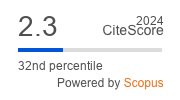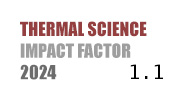THERMAL SCIENCE
International Scientific Journal
RESEARCH ON DEFLAGRATION BEHAVIOR OF GAS AND GAS-COAL DUST IN A VERTICAL PRESSURE RELIEF PIPE-LINE SYSTEM
ABSTRACT
Gas explosion and gas-coal dust explosion are serious disasters in coal mine production. To further study the hazards of gas explosion and gas and coal dust explosion under different conditions, experiments were done in this paper in a pipe-line system containing an explosion pipe-line and pressure relief pipe-line. Flame propagation behavior and overpressure dynamics of gas explosion and gas coal dust explosion were analyzed. Flame propagation behavior of gas explosion and gas-coal dust explosion are divided into three-stages: spherical flame, round-finger flame, and pointed-finger flame. Flame front position increases with time showing a class exponential growth trend. Flame front velocity has been increasing in the explosion pipe-line. When the flame rushes out of the PVC membrane and enters the pressure relief pipe-line, flame front velocity decreases slightly. The flame front velocity increases rapidly in the pressure relief pipe-line. With growing gas concentration, the peak overpressure in the explosion pipe-line rises at first, then decrease, and the peak overpressure in the pressure relief pipe-line keeps rising. Peak overpressures are obtained at gas concentrations of 9 vol.% and 13 vol.%, respectively. When gas concentrations are 7 vol.% and 9 vol.% in the reaction, the peak overpressures in the pressure relief pipe-line during gas explosion and gas-coal dust explosion are all lower than those in the explosion pipe-line. When gas concentrations are 11 vol.% and 13 vol.% in the reaction, the peak overpressures in the pressure relief pipe-line during the two types of explosions are higher than those in the explosion pipe-line.
KEYWORDS
PAPER SUBMITTED: 2022-11-04
PAPER REVISED: 2022-12-14
PAPER ACCEPTED: 2022-12-18
PUBLISHED ONLINE: 2023-03-11
THERMAL SCIENCE YEAR
2023, VOLUME
27, ISSUE
Issue 5, PAGES [4063 - 4075]
- Jing, G. X., et al., Investigation on The Characteristics of Single-phase Gas Explosion and Gas-coal Dust Coupling Explosion in Bifurcated Tubes, Thermal Science, 25 (2021), 5A, pp. 3595-3605
- Gao, W., et al., Dobashi, R., Flame Propagation Mechanisms in Dust Explosions, Journal of LossPrevention in the Process Industries, 36 (2015), July, pp. 188-196
- Wang, J., et al., Experimental Study on the Ignition Sensitivity and Explosion Severity of Different Ranks of Coal Dust, Shock and Vibration, 2019 (2019), ID2763907
- Kundu, S. K., et al., Explosion Severity of Methane-Coal Dust Hybrid Mixtures in a Ducted Spherical Vessel, Powder Technology, 323 (2018), Jan., pp. 95-102
- Kundu, S. K., et al., Moghtaderi B, Explosion Characteristics of Methane - Air Mixtures in a Spherical Vessel Connected with a Duct, Process Safety and Environmental Protection, 111 (2016), Oct., pp. 85-93
- Ajrash, M. J., et al., The Flame Deflagration of Hybrid Methane Coal Dusts in a Large-Scale Detonation Tube (LSDT ), Fuel, 194 (2017), Apr., pp. 491-502
- Ajrash, M. J., et al., Impact of Suspended Coal Dusts on Methane Deflagration Properties in a Large-Scale Straight Duct, Journal of Hazardous Materials, 338 (2017), Sept., pp. 334-342
- Liu, Y., et al., Flame Propagation in Hybrid Mixture of Coal Dust and Methane, Journal of LossPrevention in the Process Industries, 20 (2007), 4-6, pp. 691-697
- Zhu, C., et al., Experimental Study on the Effect of Bifurcations on the Flame Speed of Premixed Methane/Air Explosions in Ducts, Journal of LossPrevention in the Process Industries, 49 (2017), Part B, pp. 545-550
- Li, G., et al., Influence of coal Particles 0n Methane/Air Mixture Ignition in a Heated Environment, Journal of Loss Prevention in the Process Industries, 26 (2013), 1, pp. 91-95
- Liu, Z., et al., Experimental Investigations on Explosion Behaviors of Large-Particle and Formation Rules of Gas Residues, Journal of LossPrevention in the Process Industries, 46 (2017), Mar., pp. 37-44
- Man, C. K., et al., Participation of Large Particles in Coal Dust Explosions, Journal of Loss Prevention in the Process Industries, 27 (2014), Jan., pp. 49-54
- Li, Q., et al., Experimental Analysis on Post-Explosion Residues for Evaluating Coal Dust Explosion Severity and Flame Propagation Behaviors, Fuel, 215 (2018), Mar., pp. 417-428
- Li, Q., et al., Experimental Research of Particle Size and Size Dispersity on the Explosibility Characteristics of Coal Dust, Powder Technology, 292 (2016), May, pp. 290-297
- Zhao, P., et al., Minimum Explosion Concentration of Coal Dusts in Air with Small Amount of CH4/H2/CO under 10 kJ Ignition Energy Conditions, Fuel, 260 (2020), 116401
- Ma, D., et al., Study on the Explosion Characteristics of Methane - Air with Coal Dust Originating from Low-Temperature Oxidation of Coal, Fuel, 260 (2020), 116304
- Wang, S., et al., Effect of the Ignition Delay Time on Explosion Severity Parameters of Coal Dust/Air Mixtures, Powder Technology, 342 (2019), Jan., pp. 509-516
- Cao, W., et al., Experimental and Numerical Studies on the Explosion Severities of Coal Dust/Air Mixtures in a 20 L Spherical Vessel, Powder Technology, 310 (2017), Apr., pp.17-23
- Wang, X., et al., Numerical Simulation of Coal Dust Explosion Suppression by Inert Particles In Spherical Confined Storage Space, Fuel, 253 (2019), Oct., pp. 1342-1350
- Song, Y., Zhang, Q., Multiple Explosions Induced by the Deposited Dust Layer in Enclosed Pipe-Line, Journal of Hazardous Materials, 371 (2019), June, pp. 423-432
- Houim, R, W., Oran, E, S., Numerical Simulation of Dilute and Dense Layered Coal-Dust Explosions, Proceedings of the Combustion Institute, 35 (2015), 2, pp. 2083-2090
- Houim, R, W., Oran, E, S., Structure and Flame Speed of Dilute and Dense Layered Coal-Dust Explosions, Journal of LossPrevention in the Process Industries, 36 (2015), July, pp. 214-222
- Yu, M., et al., Experimental Study of Premixed Syngas/Air Flame Propagation in a Half-Open Duct, Fuel, 225 (2018), Aug., pp.192-202
- Ibrahim, S. S., Masri, A. R., The Effects of Obstructions on Overpressure Resulting from Premixed Flame Deflagration, Journal of LossPrevention in the Process Industries, 14 (2001), 3, pp. 213-221
- Wang, Y., et al., Suppression of Polyethylene Dust Explosion by Sodium Bicarbonate, Powder Technology, 367 (2020), May, pp. 206-212
- Zheng, L., et al., The Premixed Methane/Air Explosion Inhibited by Sodium Bicarbonate with Different Particle Size Distributions, Powder Technology, 354 (2019), Sept., pp. 630-640
- Wang, Q., et al., Flame Propagation and Spectrum Characteristics of CH4-Air Gas Mixtures in a Vertical Pressure Relief Pipe-Line, Fuel, 317 (2022), 123413
- Zhang, Q., et al., Effect of DME Addition on Flame Dynamics of LPG/DME Blended Fuel in Tail Space of Closed Pipe-Line, Energy, 202 (2020), 117746
- Yang, X., et al., Effect of Equivalence Ratio and Ignition Location on Premixed Syngas-Air Explosion in a Half-Open Duct, Fuel, 288 (2021), 119724
- Ma, Q., et al., Effects of Premixed Methane Concentration on Distribution of Flame Region and Hazard Effects in a Tube and a Tunnel Gas Explosion, Journal of LossPrevention in the Process Industries, 34 (2015), Mar., pp. 30-38
- Lin, S., et al., Flame Characteristics in a Coal Dust Explosion Induced by a Methane Explosion in a Horizontal Pipe-line, Combust Science and Technology, 194 (2022), 3, pp. 622-635
- Ponizy, B., et al., Tulip flame - The Mechanism of Flame Front Inversion, Combust Flame, 161 (2014), 12, pp. 3051-3062
- Guo, C., et al., Effect of Low-Concentration Coal Dust on Gas Explosion Propagation Law, Powder Technology, 367 (2020), May, pp. 243-252
- Dong, C., et al., Effects of Obstacles and Deposited Coal Dust on Characteristics of Premixed Methane-Air Explosions in a Long Closed Pipe, Safety Science, 50 (2012), 9, pp. 1786-1791
- Kindracki, J., et al., Influence of Ignition Position and Obstacles on Explosion Development in Methane-Air Mixture In Closed Vessels, Journal of LossPrevention in the Process Industries, 20 (2007), 4-6, pp. 551-561

